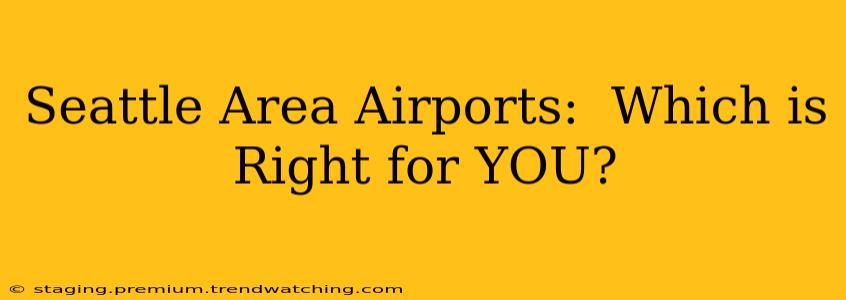The Seattle metropolitan area boasts three major airports, each catering to different needs and preferences. Choosing the right airport can significantly impact your travel experience, saving you time, money, and stress. This guide will help you navigate the options and select the perfect airport for your journey.
Seattle-Tacoma International Airport (SEA): The Big One
Seattle-Tacoma International Airport (SEA) is the region's largest and busiest airport, serving as the primary gateway for most travelers. Its sheer size translates to a vast array of flight options, both domestic and international, with connections to virtually every major city worldwide.
Pros:
- Extensive Flight Network: SEA offers an unparalleled number of flights and airlines, ensuring a wide range of choices and competitive pricing.
- Amenities: Expect a comprehensive range of amenities, including numerous restaurants, shops, lounges, and comfortable seating areas.
- Transportation Options: SEA is well-connected to the city via light rail, buses, taxis, ride-sharing services, and rental cars. The Link Light Rail provides a direct, efficient, and affordable connection to downtown Seattle.
- International Travel Hub: SEA is a major international airport, making it the ideal choice for international travelers.
Cons:
- Crowds and Congestion: The sheer volume of passengers can lead to long lines at security checkpoints and gates, especially during peak travel times.
- Distance from some destinations: If your final destination is outside of Seattle proper (e.g., Bellevue, Tacoma), getting to your final location might take significantly longer than from other, closer airports.
- Higher Costs: Expect to pay more for parking, transportation, and potentially even food and drinks due to higher demand.
Paine Field (PAE): Snohomish County's Convenient Option
Located in Everett, Paine Field (PAE) is a smaller, more convenient alternative, primarily serving domestic flights. Its growing popularity is largely due to its proximity to Boeing's Everett factory and the northern suburbs of Seattle.
Pros:
- Less Congestion: Expect significantly shorter lines and wait times compared to SEA.
- Proximity to North Seattle and Everett: Ideal for travelers headed to the north suburbs or those visiting Boeing.
- Faster Security: The smaller passenger volume results in quicker security screenings.
- Free Wi-Fi: Paine Field offers free and reliable Wi-Fi throughout the airport.
Cons:
- Limited Flight Options: PAE offers fewer airlines and flight destinations compared to SEA. Most flights are domestic.
- Fewer Amenities: Expect a more limited selection of restaurants, shops, and other amenities.
- Transportation Limitations: Public transportation options are less extensive than at SEA.
Renton Municipal Airport (RNT): For General Aviation & Private Flights
Renton Municipal Airport (RNT) is primarily a general aviation airport, serving smaller aircraft, private jets, and flight schools. It's not a viable option for most commercial travelers.
Pros:
- Convenient for Private Flights: Ideal if you are using a private jet or small aircraft.
- Flight Training: Home to several flight schools.
Cons:
- No Commercial Flights: RNT doesn't offer scheduled commercial flights.
- Limited Services: Amenities and transportation options are extremely limited.
Which Airport is Best for You?
The best airport for you depends on several factors:
- Your Destination: If you are heading to downtown Seattle, SEA is generally the most convenient choice. For destinations in the north suburbs, PAE might be a better option.
- Your Budget: SEA is likely to be more expensive due to higher fees and potentially higher prices for services and amenities.
- Your Flight Options: SEA offers the broadest selection of flights and airlines.
- Your Tolerance for Crowds: If you prefer a less crowded experience, PAE might be a better option.
By carefully considering these factors, you can choose the airport that best suits your individual needs and preferences for a smoother and more enjoyable travel experience.

